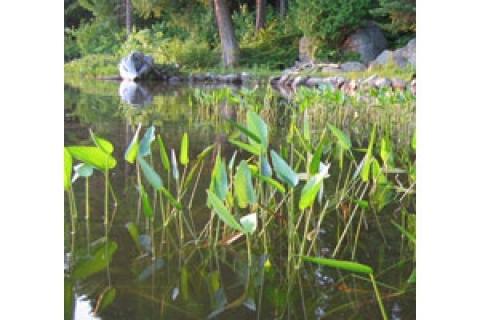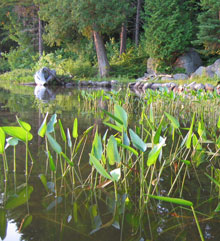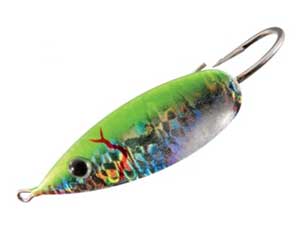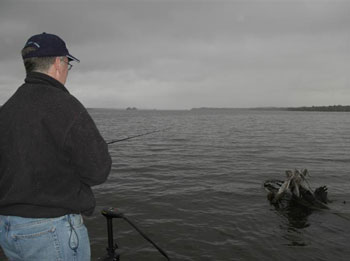
Learning to effectively fish cover is a fundamental angling skill. In this article, I'll overview some common types of cover found in lakes and river systems and share tips on how to fish them for a variety of species.
Cover Versus Structure
 |
| Thick growth can be difficult to fish beyond the short-cast tactics of pitching and flipping. |
These two terms are sometimes used interchangeably, but they are not the same. When you get down to it, structure refers to the physical characteristics of the water body, such as points, reefs and islands. Cover, on the other hand, is the add-on features, such as docks, fallen trees and vegetation. A good way to remember the distinction is that if you were to drain all the water from a lake, the structures would not move.
Why Cover is Important
Fish relate to cover for shelter and security from the sun and predators. At the same time, cover provides predators with hiding and ambush areas. Elaborate and large areas of cover are like "aquatic neighborhoods" with each stage of the food chain present. From insects, to pumpkinseeds, to largemouth, cover serves as a place where fish come to feed, or hide-out in an effort to avoid being eaten.
Vegetation
As noted in the above example, aquatic vegetation is prime fishing cover. A good way to talk about weeds is by classifying them into floating, emergent and submerged categories as each has slightly different features for fish.
Floating Vegetation: Many anglers affectionately refer to floating vegetation as "slop". Slop is often sought-out by largemouth bass enthusiasts. Slop is a combination of thin, strand-like algae and other floating vegetation that is mixed with emergent plants (like lily pads and coontail). In bays with limited water movement, slop sticks to other types of weeds, forming a large, floating mat that attracts largemouth. In deeper bays, slop will also hold pike and muskie.
Fishing slop is extremely fun when the fish are on and you have the right tools. Wander into a slop-filled bay with a spinning rod and eight-pound test and, to loosely quote the movie The Untouchables, "You've brought a knife to a gun fight".
Slop requires heavy-action rods and heavy line (with 17-pound test monofilament or fluorocarbon and 30-pound test braid being recommended minimums). Lure choices include weedless soft-plastics or surface baits. Some of my favorite lures to use to fish slop are lizards or paddletail worms teamed with heavy sinkers to punch through the thick mats. Floating frogs such as Bass Pro Shops' Tender Toad or toads such as Gambler's Cane Toad are also great slop baits. When a bass explodes on one of these, its sends both weeds and your heart rate soaring.
 |
| Weedless spoons can excel in average growth areas. |
Emergent Vegetation: An emergent plant grows in the water with some of its top extending beyond the surface. Reeds or bulrushes are an example of emergent vegetation. In dense populations these plants will hold a variety of species. Thick growth can be difficult to fish beyond the short-cast tactics of pitching and flipping.
Reeds and bulrushes are a prime largemouth spots in certain conditions. My favorite time to fish reeds and bulrushes is when they are being pounded with a warm, summer wind and waves. This pattern has held for me on numerous outings, and tossing Colorado-bladed spinnerbaits or Texas-rigged plastics have taken several largemouth aggressively feeding among the reeds.
Reeds are also a regular haunt for northern pike early in the season. Weedless swimming spoons can excel in average growth areas. These baits let you to quickly cover a lot of water in search for roaming northerns. Examples include Bass Pro Shops' XPS Lazer Eye Weedless Spoon, Northland's Jaw Breaker and Johnson's Original Silver Minnow.
Lastly, reeds will hold panfish, like crappies and bluegills, in early spring. Slip bobbers and small micro jigs will easily take these pint-sized fish.
Submerged Vegetation: Submerged weeds make up a large percentage of fishing cover and will attract a variety of fish species. Weedflats and weedlines are two common examples. Walleye, bass, pike, muskie, trout and panfish are all drawn to weedflats and weedlines.
To work the edges of weeds, you can use lures like crankbaits, spinnerbaits or swimbaits. To fish the thick stuff, you need gear that's fairly weedless. For walleye, consider a Lindy Veg-E-Jig. Largemouth and smallmouth can be fooled using soft jerkbaits or topwater baits. When it comes to pike and muskie, it's tough to beat an inline spinner or a bucktail spinnerbait on a fast retrieve over the top of weeds.
If targeting trout in weeds, my best success has come when trolling wet flies over their tops. It's a simple approach, but it's fooled many rainbows for me over the years.
The Wonder of Wood
 |
| When you locate wood, fish it. Timber can attract all types of bass and other game fish. |
Wood is a relatively broad category when it comes to fishing cover. It can include sunken logs, standing timber, fallen trees (laydowns), beaver dams, docks and more. The point is, when you locate wood — fish it. Wood is less forgiving than weeds when you get snagged and it can be frustrating to fish if you aren't used to it. Snags will happen if you're not paying attention. Here are some tips for fishing the various types of wood cover.
Standing Timber: Timber can attract all types of bass and other game fish as well. Often common in reservoirs, working these trees calls for heavy duty gear and precision fishing. Straight retrieve topwater baits can shine during low-light and overcast conditions, some examples include buzzbaits, Heddon's Wounded Zara Spook or Rapala's Skitter Pop. Spinnerbaits will also work when the timber isn't too dense. Flipping jigs or Texas-rigged plastics may be better to fish the thick stuff.
Fallen Trees and Beaver Dams: There are dozens of methods to fish fallen trees (also called laydowns). Most often associated with bass and panfish, I've also hooked muskie and pike from laydowns. Topwaters or big jigs with brush guards are two good options to fish these trees. These tactics will also work to fish beaver dams.
Fallen trees can also be phenomenal for brook trout as well as other trout species. Small inline spinners, spoons and flies will take trout around wood. Find a beaver dam on a trout lake and approach it with respect as it may hold a trophy speckled trout.
Docks: Docks are a beacon to many anglers, symbolizing a trophy's fortress. To give yourself an edge, learn to approach and fish docks quietly. This ensures you won't spook fish. If you can, work docks first with long casts, then move in and use short pitch and flip casts. Use snag-resistant lures to lessen your chances of snags, which dock owners will appreciate.
Other Types of Cover
Weeds and wood are the two main categories when it comes to fishing cover, but you may stumble on other fish-holding stuff during your adventures. For example, you may not initially think of tires as a good piece of cover, but these sunken circles will sometimes hold big largemouth bass.
When you find a new piece of cover, look at it in the context of the surrounding water features. Being inquisitive will result in you learning to differentiate between good versus bad types of cover and answer questions like: Why does this bay of lily pads hold bass but the other one doesn't? Or why are all the rainbow trout relating to sunken logs on this side of the lake?
Consider cover in the larger context of the water body you're fishing, and you'll improve your angling know-how over the seasons.
Improve Your Sight
What's the one constant for shallow-water fishing around cover? Wear polarized sunglasses. They reduce the glare off the surface, letting you see easier through the water. Being able to see cover is critical to being able to fish it properly. Invest in a quality pair of sunglasses if you don't already own polarized shades. They'll make you a much better angler when fishing cover.
- 14140 views

